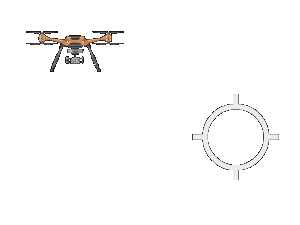Drones have evolved into highly sophisticated tools with significant detection challenges for military forces. Their small size and advanced technological features make these aerial devices challenging to spot and track using traditional methods. Their advanced electronics and communication systems enable them to easily evade most conventional tracking solutions. This complexity is further compounded by their ability to adapt quickly to counter-detection measures.
This article examines why drones are so challenging to detect from a military perspective, highlighting the role of Radio Frequency (RF) solutions and Electronic Warfare (EW) technologies in addressing these difficulties.
The Rising Threat of Drones in Military Operations
The Evolution of Drone Technology
Drones have rapidly evolved from essential reconnaissance tools to sophisticated weapon systems capable of carrying out various missions, including surveillance, intelligence gathering, and targeted strikes. Their compact design and ability to operate at multiple altitudes make them difficult to detect using conventional military radar systems. As drones become more prevalent in both state and non-state military operations, the need for effective detection and countermeasures has become increasingly urgent.
The Risks Posed by Drones to Soldiers and Military Compounds
Drones pose significant risks to both soldiers in the field and military compounds. Their ability to fly at low altitudes and navigate through complex environments allows them to approach targets undetected. This stealth capability can be exploited for surveying, delivering explosives, or even conducting electronic warfare against military assets, showcasing the adaptability of the threat. The potential for drones to bypass traditional security measures puts soldiers and critical infrastructure at considerable risk, making effective detection systems a top priority for military defense.

Understanding the Complexities of Drone Detection
Advanced Stealth and Maneuverability
Many modern drones are too small to be detected by radar systems. Furthermore, drones are highly maneuverable, allowing them to change altitude, speed, and direction quickly, making it difficult for detection systems to track them consistently. This combination of stealth and agility poses a significant challenge for military forces relying on traditional detection methods.
The Challenge of Track Down Drone RF Signals
In addition to their physical stealth, drones often use low-power radio frequency (RF) signals for communication and navigation. These signals are difficult to detect because they blend in with the vast array of electronic noise present in modern military environments. RF detection systems must distinguish between drone signals and background noise, a complex and resource-intensive task. The proliferation of commercial drones and other RF-emitting devices further complicates this challenge, making it harder to identify potential threats.
RF Solutions in Electronic Warfare
The Role of RF Detection in Counter-Drone Strategies
Radio Frequency (RF) detection is a critical component of electronic warfare, particularly in counter-drone operations. RF detection systems are designed to monitor the electromagnetic spectrum for signals that indicate the presence of a drone. These systems can detect the RF communication between a drone and its operator, providing early warning of an approaching threat. Once a drone is detected, military forces can take appropriate countermeasures such as jamming the drone’s communication link, deploying kinetic defenses or takeover the drone.
Advanced RF Sensors and Signal Processing
Defense and technology companies are developing advanced RF sensors with enhanced sensitivity and signal processing capabilities to detect and counter drones effectively. These sensors can scan a wide range of frequencies and filter out background noise to identify potential drone threats. Signal processing algorithms can analyze the detected RF signals to determine the type of drone, its location, and its flight path. This information is crucial for making informed decisions about whether and how to neutralize the threat.

Protecting Soldiers and Military Compounds from Drone Threats
Detection Sensors in Various Customized Configurations
In an era of emerging aerial threats, the need for adaptable RF detection sensors is more critical than ever to safeguard soldiers and military compounds. These sensors, available in various customized configurations, offer the versatility required to meet diverse operational needs. Whether mounted on vehicles, integrated into fixed installations, or carried in a manpack by individual soldiers, they provide comprehensive protection across different scenarios. This flexibility ensures that military forces can deploy the most suitable configuration for any mission, enhancing the security of troopers, military bases and other infrastructure against drone threats.
Integrating Drone Detection and Jamming Technologies for Enhanced Security
Integrating detection and jamming technologies in the modern battlefield is crucial for meeting military security needs, especially in electronic warfare. By combining RF detection sensors with advanced jamming systems, military forces can detect and disrupt hostile drones’ communications, neutralizing threats before they endanger soldiers or critical assets. This integrated approach is essential for protecting military compounds and enhancing overall force protection. As electronic warfare becomes an increasingly crucial component of military strategy, the synergy between detection and jamming technologies provides a robust defense against the evolving challenges posed by drone threats.
Conclusion
From a military perspective, drones’ increasing sophistication and stealth pose a significant challenge to traditional detection and defense systems. Their small size, advanced electronic features, and adaptive capabilities complicate efforts to detect and track them using conventional methods. This complexity underscores the necessity of leveraging electronic warfare (EW) solutions to address these challenges. By integrating RF detection sensors with EW technologies, such as advanced jamming systems, military forces can enhance their ability to detect, track, and neutralize drone threats effectively. These integrated EW solutions provide a critical defense mechanism, safeguarding soldiers and strategic military assets. As drones become more prevalent in modern warfare, adopting and refining EW technologies will be essential for maintaining robust security and ensuring military readiness against evolving aerial threats.




